Organizational Behavior Report: Culture, Motivation and Teams
VerifiedAdded on 2023/01/11
|17
|5848
|85
Report
AI Summary
This report provides a comprehensive analysis of organizational behavior, focusing on the influence of culture, politics, and power on individual and team performance, using Waitrose as a case study. It examines various organizational behavior theories and models, including Handy's model of organizational culture, Hofstede's cultural dimensions, and different types of organizational power (legitimate, expert, and reward). The report also delves into content and process theories of motivation, particularly Maslow's hierarchy of needs, and explores how these theories and motivational techniques can facilitate the effective achievement of organizational goals. Furthermore, the report assesses the dynamics of effective and ineffective teams, group development theories, and the application of organizational behavior philosophies. The report offers critical evaluations and recommendations to enhance team and organizational success, emphasizing the interconnectedness of culture, politics, power, and motivation.
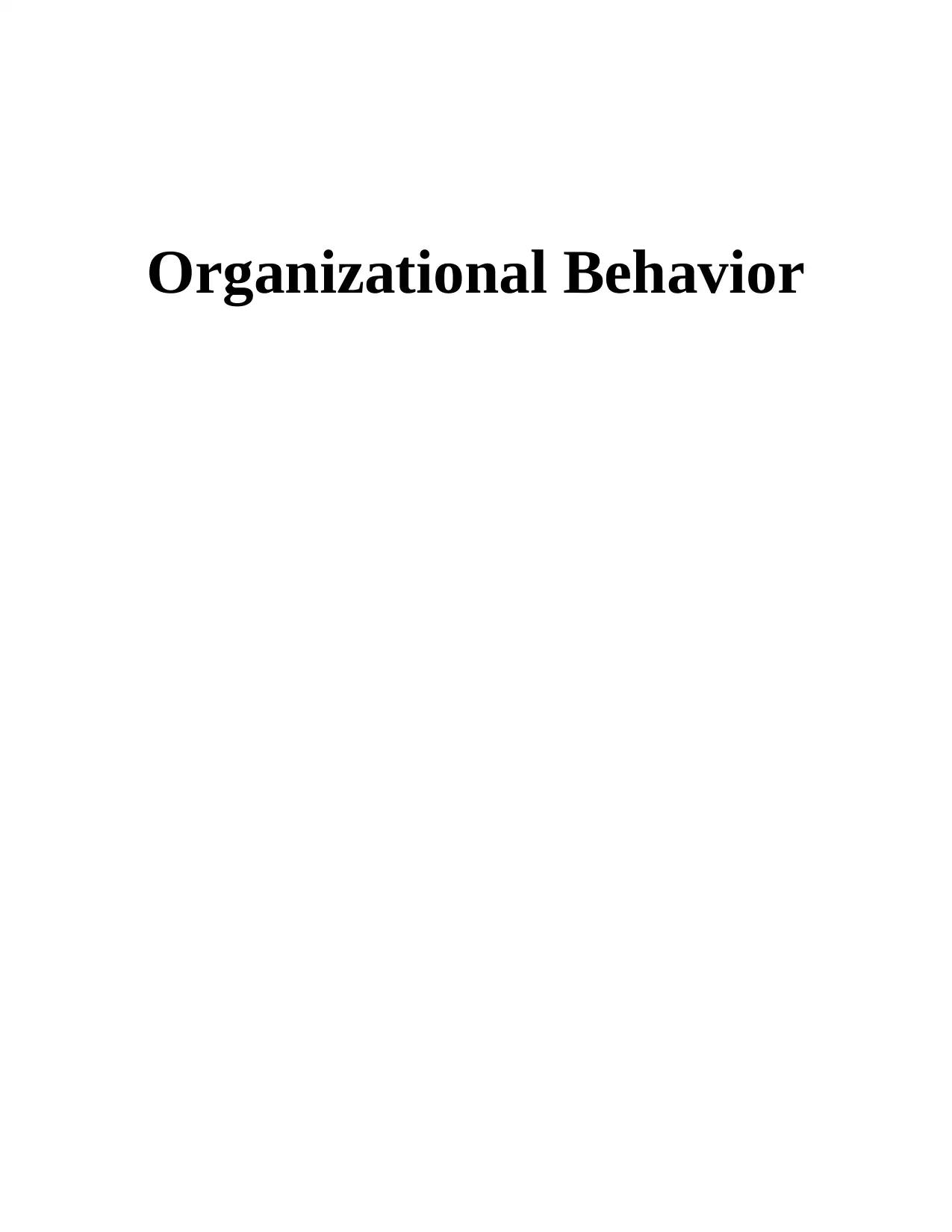
Organizational Behavior
Paraphrase This Document
Need a fresh take? Get an instant paraphrase of this document with our AI Paraphraser
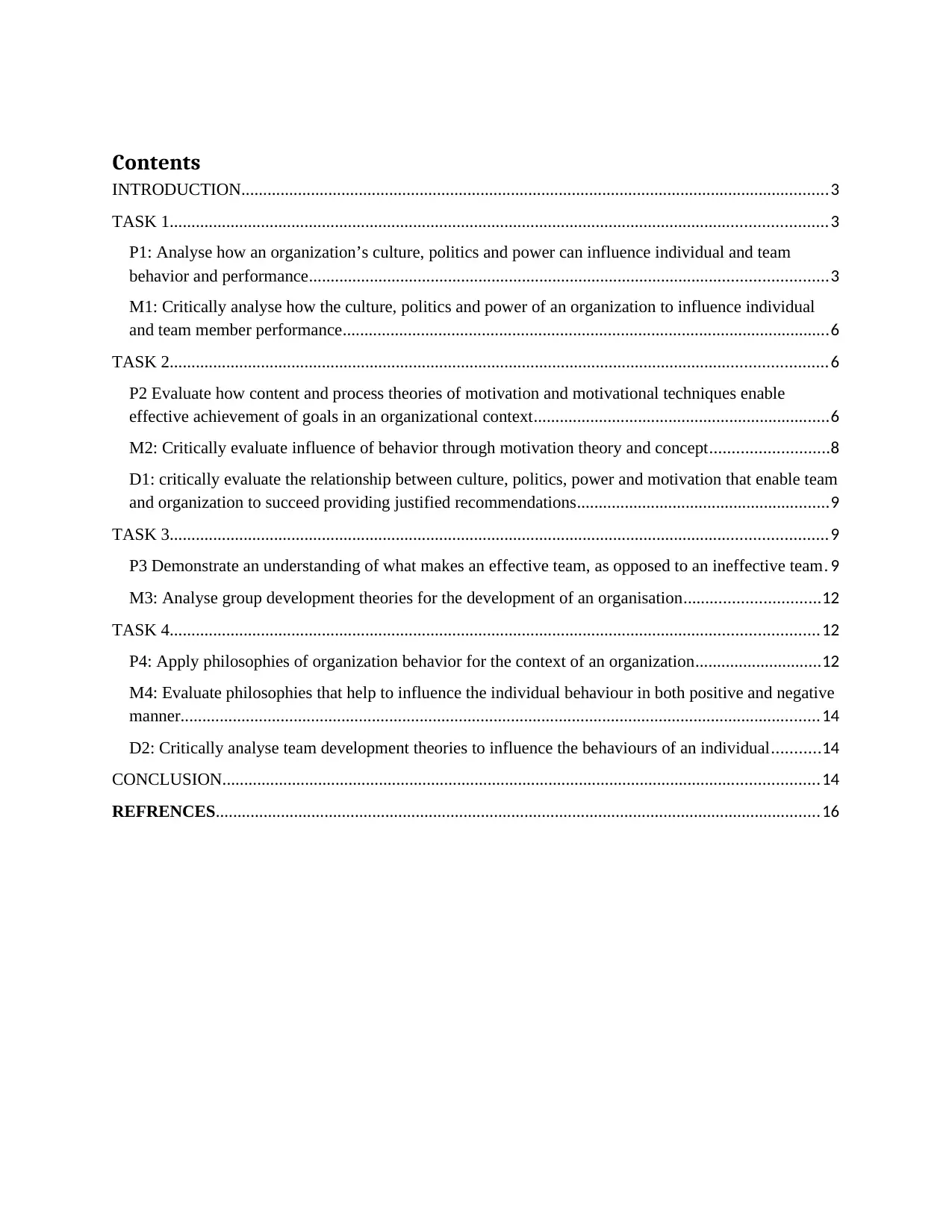
Contents
INTRODUCTION.......................................................................................................................................3
TASK 1.......................................................................................................................................................3
P1: Analyse how an organization’s culture, politics and power can influence individual and team
behavior and performance.......................................................................................................................3
M1: Critically analyse how the culture, politics and power of an organization to influence individual
and team member performance................................................................................................................6
TASK 2.......................................................................................................................................................6
P2 Evaluate how content and process theories of motivation and motivational techniques enable
effective achievement of goals in an organizational context....................................................................6
M2: Critically evaluate influence of behavior through motivation theory and concept...........................8
D1: critically evaluate the relationship between culture, politics, power and motivation that enable team
and organization to succeed providing justified recommendations..........................................................9
TASK 3.......................................................................................................................................................9
P3 Demonstrate an understanding of what makes an effective team, as opposed to an ineffective team. 9
M3: Analyse group development theories for the development of an organisation...............................12
TASK 4.....................................................................................................................................................12
P4: Apply philosophies of organization behavior for the context of an organization.............................12
M4: Evaluate philosophies that help to influence the individual behaviour in both positive and negative
manner...................................................................................................................................................14
D2: Critically analyse team development theories to influence the behaviours of an individual...........14
CONCLUSION.........................................................................................................................................14
REFRENCES...........................................................................................................................................16
INTRODUCTION.......................................................................................................................................3
TASK 1.......................................................................................................................................................3
P1: Analyse how an organization’s culture, politics and power can influence individual and team
behavior and performance.......................................................................................................................3
M1: Critically analyse how the culture, politics and power of an organization to influence individual
and team member performance................................................................................................................6
TASK 2.......................................................................................................................................................6
P2 Evaluate how content and process theories of motivation and motivational techniques enable
effective achievement of goals in an organizational context....................................................................6
M2: Critically evaluate influence of behavior through motivation theory and concept...........................8
D1: critically evaluate the relationship between culture, politics, power and motivation that enable team
and organization to succeed providing justified recommendations..........................................................9
TASK 3.......................................................................................................................................................9
P3 Demonstrate an understanding of what makes an effective team, as opposed to an ineffective team. 9
M3: Analyse group development theories for the development of an organisation...............................12
TASK 4.....................................................................................................................................................12
P4: Apply philosophies of organization behavior for the context of an organization.............................12
M4: Evaluate philosophies that help to influence the individual behaviour in both positive and negative
manner...................................................................................................................................................14
D2: Critically analyse team development theories to influence the behaviours of an individual...........14
CONCLUSION.........................................................................................................................................14
REFRENCES...........................................................................................................................................16
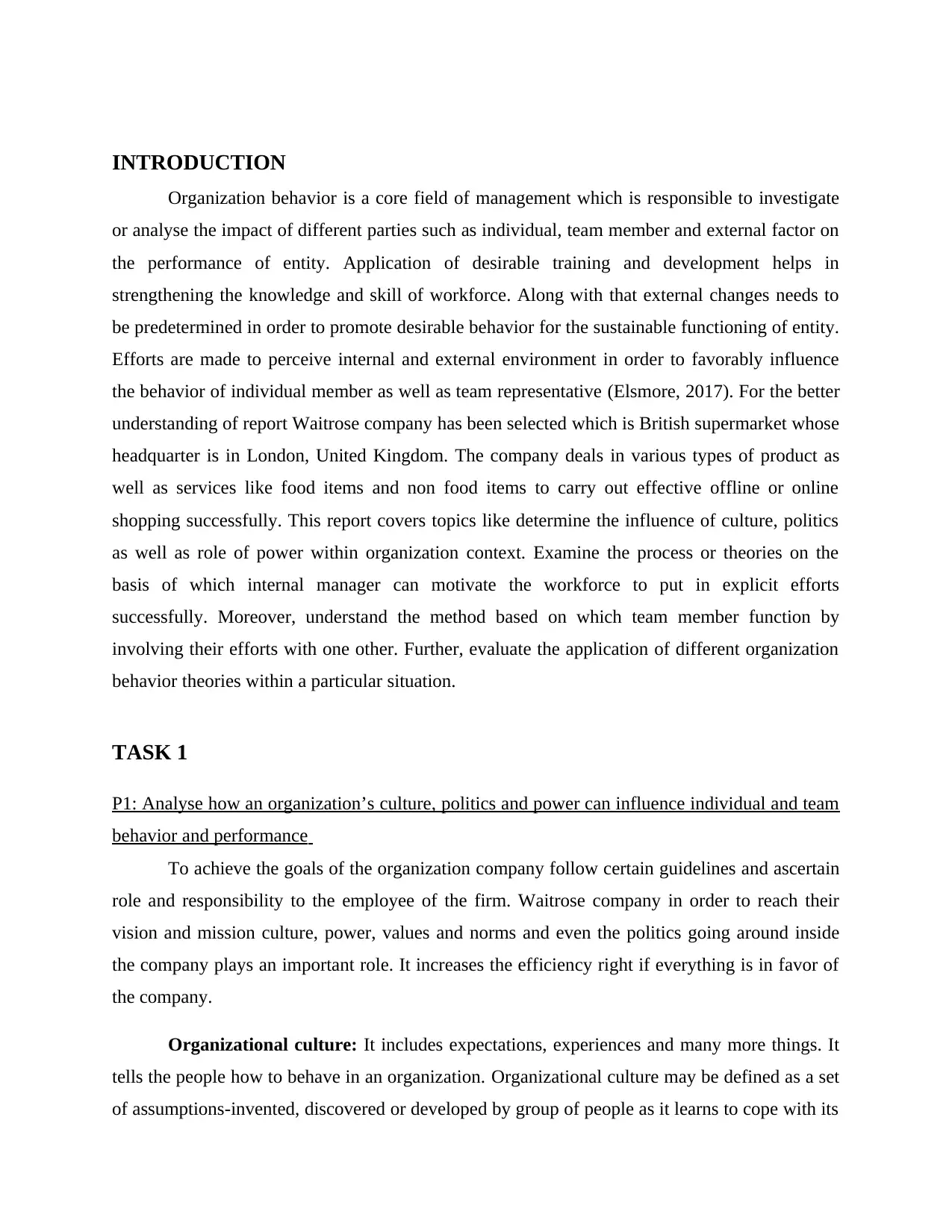
INTRODUCTION
Organization behavior is a core field of management which is responsible to investigate
or analyse the impact of different parties such as individual, team member and external factor on
the performance of entity. Application of desirable training and development helps in
strengthening the knowledge and skill of workforce. Along with that external changes needs to
be predetermined in order to promote desirable behavior for the sustainable functioning of entity.
Efforts are made to perceive internal and external environment in order to favorably influence
the behavior of individual member as well as team representative (Elsmore, 2017). For the better
understanding of report Waitrose company has been selected which is British supermarket whose
headquarter is in London, United Kingdom. The company deals in various types of product as
well as services like food items and non food items to carry out effective offline or online
shopping successfully. This report covers topics like determine the influence of culture, politics
as well as role of power within organization context. Examine the process or theories on the
basis of which internal manager can motivate the workforce to put in explicit efforts
successfully. Moreover, understand the method based on which team member function by
involving their efforts with one other. Further, evaluate the application of different organization
behavior theories within a particular situation.
TASK 1
P1: Analyse how an organization’s culture, politics and power can influence individual and team
behavior and performance
To achieve the goals of the organization company follow certain guidelines and ascertain
role and responsibility to the employee of the firm. Waitrose company in order to reach their
vision and mission culture, power, values and norms and even the politics going around inside
the company plays an important role. It increases the efficiency right if everything is in favor of
the company.
Organizational culture: It includes expectations, experiences and many more things. It
tells the people how to behave in an organization. Organizational culture may be defined as a set
of assumptions-invented, discovered or developed by group of people as it learns to cope with its
Organization behavior is a core field of management which is responsible to investigate
or analyse the impact of different parties such as individual, team member and external factor on
the performance of entity. Application of desirable training and development helps in
strengthening the knowledge and skill of workforce. Along with that external changes needs to
be predetermined in order to promote desirable behavior for the sustainable functioning of entity.
Efforts are made to perceive internal and external environment in order to favorably influence
the behavior of individual member as well as team representative (Elsmore, 2017). For the better
understanding of report Waitrose company has been selected which is British supermarket whose
headquarter is in London, United Kingdom. The company deals in various types of product as
well as services like food items and non food items to carry out effective offline or online
shopping successfully. This report covers topics like determine the influence of culture, politics
as well as role of power within organization context. Examine the process or theories on the
basis of which internal manager can motivate the workforce to put in explicit efforts
successfully. Moreover, understand the method based on which team member function by
involving their efforts with one other. Further, evaluate the application of different organization
behavior theories within a particular situation.
TASK 1
P1: Analyse how an organization’s culture, politics and power can influence individual and team
behavior and performance
To achieve the goals of the organization company follow certain guidelines and ascertain
role and responsibility to the employee of the firm. Waitrose company in order to reach their
vision and mission culture, power, values and norms and even the politics going around inside
the company plays an important role. It increases the efficiency right if everything is in favor of
the company.
Organizational culture: It includes expectations, experiences and many more things. It
tells the people how to behave in an organization. Organizational culture may be defined as a set
of assumptions-invented, discovered or developed by group of people as it learns to cope with its
⊘ This is a preview!⊘
Do you want full access?
Subscribe today to unlock all pages.

Trusted by 1+ million students worldwide
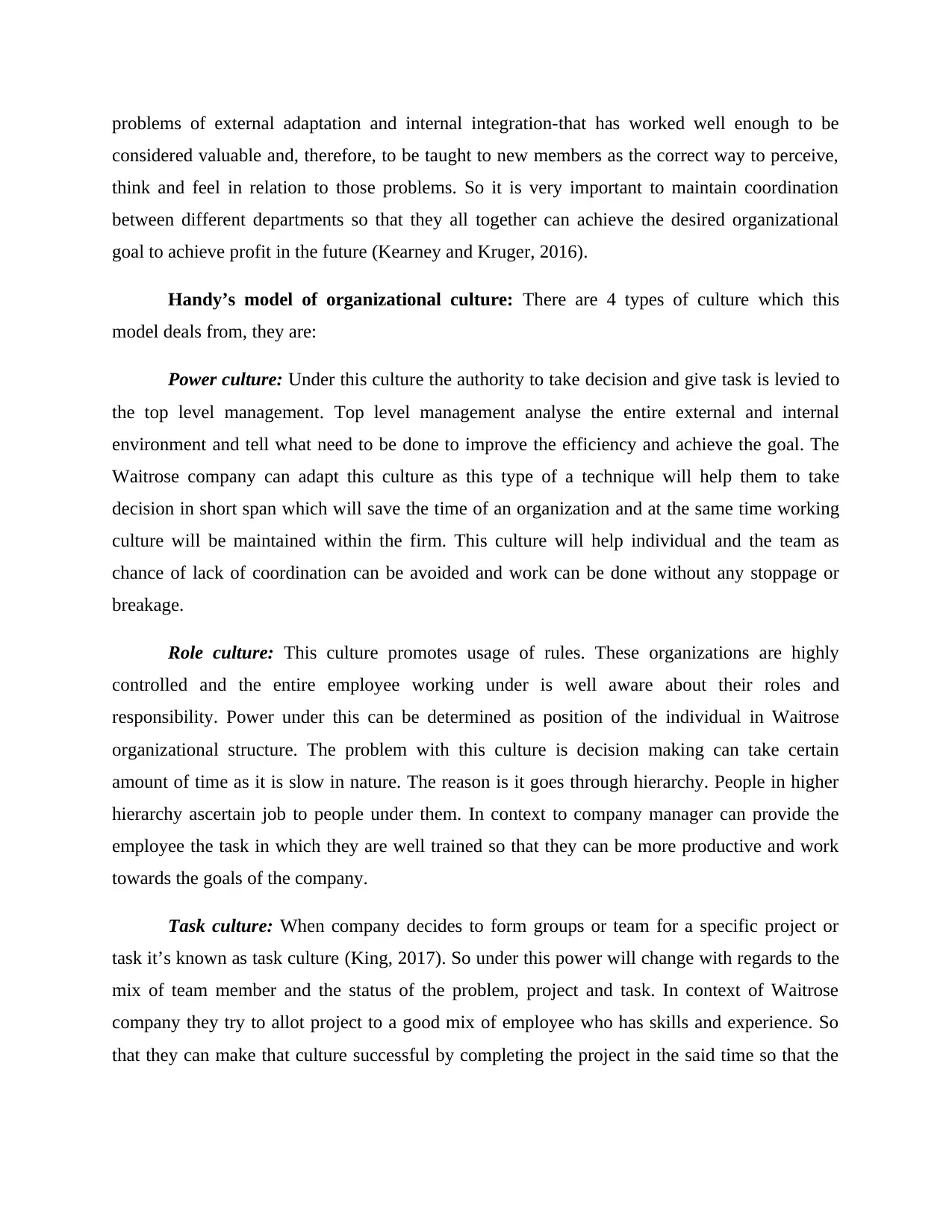
problems of external adaptation and internal integration-that has worked well enough to be
considered valuable and, therefore, to be taught to new members as the correct way to perceive,
think and feel in relation to those problems. So it is very important to maintain coordination
between different departments so that they all together can achieve the desired organizational
goal to achieve profit in the future (Kearney and Kruger, 2016).
Handy’s model of organizational culture: There are 4 types of culture which this
model deals from, they are:
Power culture: Under this culture the authority to take decision and give task is levied to
the top level management. Top level management analyse the entire external and internal
environment and tell what need to be done to improve the efficiency and achieve the goal. The
Waitrose company can adapt this culture as this type of a technique will help them to take
decision in short span which will save the time of an organization and at the same time working
culture will be maintained within the firm. This culture will help individual and the team as
chance of lack of coordination can be avoided and work can be done without any stoppage or
breakage.
Role culture: This culture promotes usage of rules. These organizations are highly
controlled and the entire employee working under is well aware about their roles and
responsibility. Power under this can be determined as position of the individual in Waitrose
organizational structure. The problem with this culture is decision making can take certain
amount of time as it is slow in nature. The reason is it goes through hierarchy. People in higher
hierarchy ascertain job to people under them. In context to company manager can provide the
employee the task in which they are well trained so that they can be more productive and work
towards the goals of the company.
Task culture: When company decides to form groups or team for a specific project or
task it’s known as task culture (King, 2017). So under this power will change with regards to the
mix of team member and the status of the problem, project and task. In context of Waitrose
company they try to allot project to a good mix of employee who has skills and experience. So
that they can make that culture successful by completing the project in the said time so that the
considered valuable and, therefore, to be taught to new members as the correct way to perceive,
think and feel in relation to those problems. So it is very important to maintain coordination
between different departments so that they all together can achieve the desired organizational
goal to achieve profit in the future (Kearney and Kruger, 2016).
Handy’s model of organizational culture: There are 4 types of culture which this
model deals from, they are:
Power culture: Under this culture the authority to take decision and give task is levied to
the top level management. Top level management analyse the entire external and internal
environment and tell what need to be done to improve the efficiency and achieve the goal. The
Waitrose company can adapt this culture as this type of a technique will help them to take
decision in short span which will save the time of an organization and at the same time working
culture will be maintained within the firm. This culture will help individual and the team as
chance of lack of coordination can be avoided and work can be done without any stoppage or
breakage.
Role culture: This culture promotes usage of rules. These organizations are highly
controlled and the entire employee working under is well aware about their roles and
responsibility. Power under this can be determined as position of the individual in Waitrose
organizational structure. The problem with this culture is decision making can take certain
amount of time as it is slow in nature. The reason is it goes through hierarchy. People in higher
hierarchy ascertain job to people under them. In context to company manager can provide the
employee the task in which they are well trained so that they can be more productive and work
towards the goals of the company.
Task culture: When company decides to form groups or team for a specific project or
task it’s known as task culture (King, 2017). So under this power will change with regards to the
mix of team member and the status of the problem, project and task. In context of Waitrose
company they try to allot project to a good mix of employee who has skills and experience. So
that they can make that culture successful by completing the project in the said time so that the
Paraphrase This Document
Need a fresh take? Get an instant paraphrase of this document with our AI Paraphraser
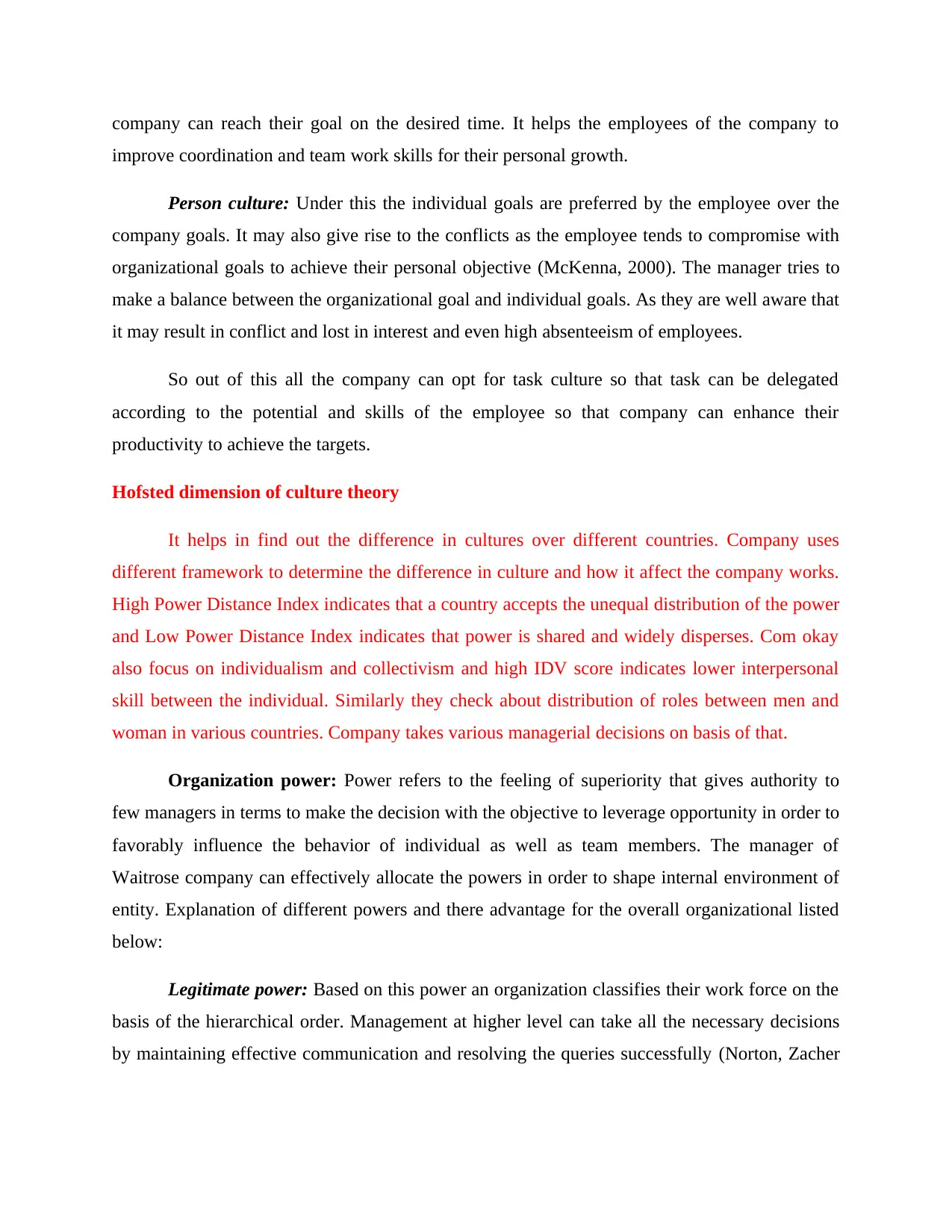
company can reach their goal on the desired time. It helps the employees of the company to
improve coordination and team work skills for their personal growth.
Person culture: Under this the individual goals are preferred by the employee over the
company goals. It may also give rise to the conflicts as the employee tends to compromise with
organizational goals to achieve their personal objective (McKenna, 2000). The manager tries to
make a balance between the organizational goal and individual goals. As they are well aware that
it may result in conflict and lost in interest and even high absenteeism of employees.
So out of this all the company can opt for task culture so that task can be delegated
according to the potential and skills of the employee so that company can enhance their
productivity to achieve the targets.
Hofsted dimension of culture theory
It helps in find out the difference in cultures over different countries. Company uses
different framework to determine the difference in culture and how it affect the company works.
High Power Distance Index indicates that a country accepts the unequal distribution of the power
and Low Power Distance Index indicates that power is shared and widely disperses. Com okay
also focus on individualism and collectivism and high IDV score indicates lower interpersonal
skill between the individual. Similarly they check about distribution of roles between men and
woman in various countries. Company takes various managerial decisions on basis of that.
Organization power: Power refers to the feeling of superiority that gives authority to
few managers in terms to make the decision with the objective to leverage opportunity in order to
favorably influence the behavior of individual as well as team members. The manager of
Waitrose company can effectively allocate the powers in order to shape internal environment of
entity. Explanation of different powers and there advantage for the overall organizational listed
below:
Legitimate power: Based on this power an organization classifies their work force on the
basis of the hierarchical order. Management at higher level can take all the necessary decisions
by maintaining effective communication and resolving the queries successfully (Norton, Zacher
improve coordination and team work skills for their personal growth.
Person culture: Under this the individual goals are preferred by the employee over the
company goals. It may also give rise to the conflicts as the employee tends to compromise with
organizational goals to achieve their personal objective (McKenna, 2000). The manager tries to
make a balance between the organizational goal and individual goals. As they are well aware that
it may result in conflict and lost in interest and even high absenteeism of employees.
So out of this all the company can opt for task culture so that task can be delegated
according to the potential and skills of the employee so that company can enhance their
productivity to achieve the targets.
Hofsted dimension of culture theory
It helps in find out the difference in cultures over different countries. Company uses
different framework to determine the difference in culture and how it affect the company works.
High Power Distance Index indicates that a country accepts the unequal distribution of the power
and Low Power Distance Index indicates that power is shared and widely disperses. Com okay
also focus on individualism and collectivism and high IDV score indicates lower interpersonal
skill between the individual. Similarly they check about distribution of roles between men and
woman in various countries. Company takes various managerial decisions on basis of that.
Organization power: Power refers to the feeling of superiority that gives authority to
few managers in terms to make the decision with the objective to leverage opportunity in order to
favorably influence the behavior of individual as well as team members. The manager of
Waitrose company can effectively allocate the powers in order to shape internal environment of
entity. Explanation of different powers and there advantage for the overall organizational listed
below:
Legitimate power: Based on this power an organization classifies their work force on the
basis of the hierarchical order. Management at higher level can take all the necessary decisions
by maintaining effective communication and resolving the queries successfully (Norton, Zacher
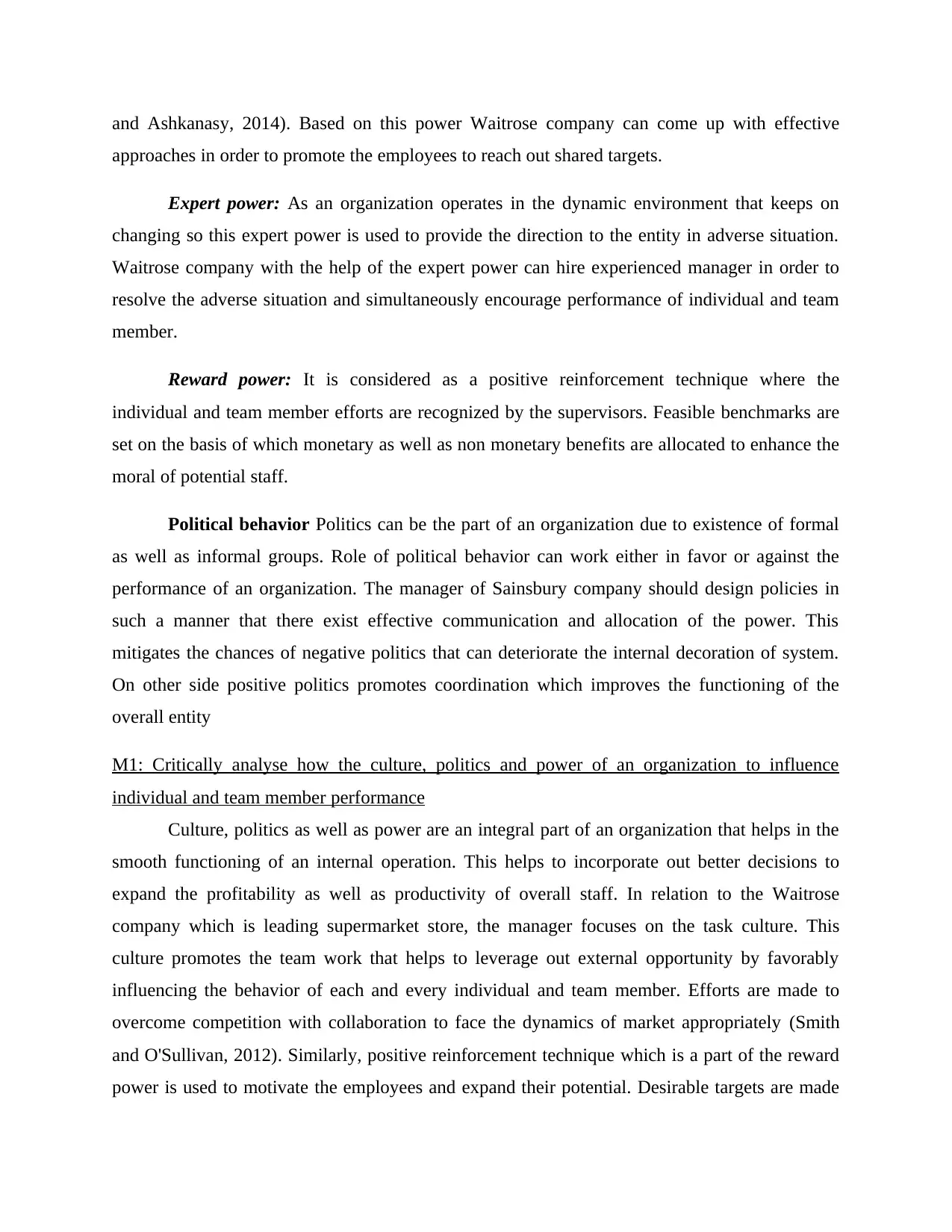
and Ashkanasy, 2014). Based on this power Waitrose company can come up with effective
approaches in order to promote the employees to reach out shared targets.
Expert power: As an organization operates in the dynamic environment that keeps on
changing so this expert power is used to provide the direction to the entity in adverse situation.
Waitrose company with the help of the expert power can hire experienced manager in order to
resolve the adverse situation and simultaneously encourage performance of individual and team
member.
Reward power: It is considered as a positive reinforcement technique where the
individual and team member efforts are recognized by the supervisors. Feasible benchmarks are
set on the basis of which monetary as well as non monetary benefits are allocated to enhance the
moral of potential staff.
Political behavior Politics can be the part of an organization due to existence of formal
as well as informal groups. Role of political behavior can work either in favor or against the
performance of an organization. The manager of Sainsbury company should design policies in
such a manner that there exist effective communication and allocation of the power. This
mitigates the chances of negative politics that can deteriorate the internal decoration of system.
On other side positive politics promotes coordination which improves the functioning of the
overall entity
M1: Critically analyse how the culture, politics and power of an organization to influence
individual and team member performance
Culture, politics as well as power are an integral part of an organization that helps in the
smooth functioning of an internal operation. This helps to incorporate out better decisions to
expand the profitability as well as productivity of overall staff. In relation to the Waitrose
company which is leading supermarket store, the manager focuses on the task culture. This
culture promotes the team work that helps to leverage out external opportunity by favorably
influencing the behavior of each and every individual and team member. Efforts are made to
overcome competition with collaboration to face the dynamics of market appropriately (Smith
and O'Sullivan, 2012). Similarly, positive reinforcement technique which is a part of the reward
power is used to motivate the employees and expand their potential. Desirable targets are made
approaches in order to promote the employees to reach out shared targets.
Expert power: As an organization operates in the dynamic environment that keeps on
changing so this expert power is used to provide the direction to the entity in adverse situation.
Waitrose company with the help of the expert power can hire experienced manager in order to
resolve the adverse situation and simultaneously encourage performance of individual and team
member.
Reward power: It is considered as a positive reinforcement technique where the
individual and team member efforts are recognized by the supervisors. Feasible benchmarks are
set on the basis of which monetary as well as non monetary benefits are allocated to enhance the
moral of potential staff.
Political behavior Politics can be the part of an organization due to existence of formal
as well as informal groups. Role of political behavior can work either in favor or against the
performance of an organization. The manager of Sainsbury company should design policies in
such a manner that there exist effective communication and allocation of the power. This
mitigates the chances of negative politics that can deteriorate the internal decoration of system.
On other side positive politics promotes coordination which improves the functioning of the
overall entity
M1: Critically analyse how the culture, politics and power of an organization to influence
individual and team member performance
Culture, politics as well as power are an integral part of an organization that helps in the
smooth functioning of an internal operation. This helps to incorporate out better decisions to
expand the profitability as well as productivity of overall staff. In relation to the Waitrose
company which is leading supermarket store, the manager focuses on the task culture. This
culture promotes the team work that helps to leverage out external opportunity by favorably
influencing the behavior of each and every individual and team member. Efforts are made to
overcome competition with collaboration to face the dynamics of market appropriately (Smith
and O'Sullivan, 2012). Similarly, positive reinforcement technique which is a part of the reward
power is used to motivate the employees and expand their potential. Desirable targets are made
⊘ This is a preview!⊘
Do you want full access?
Subscribe today to unlock all pages.

Trusted by 1+ million students worldwide
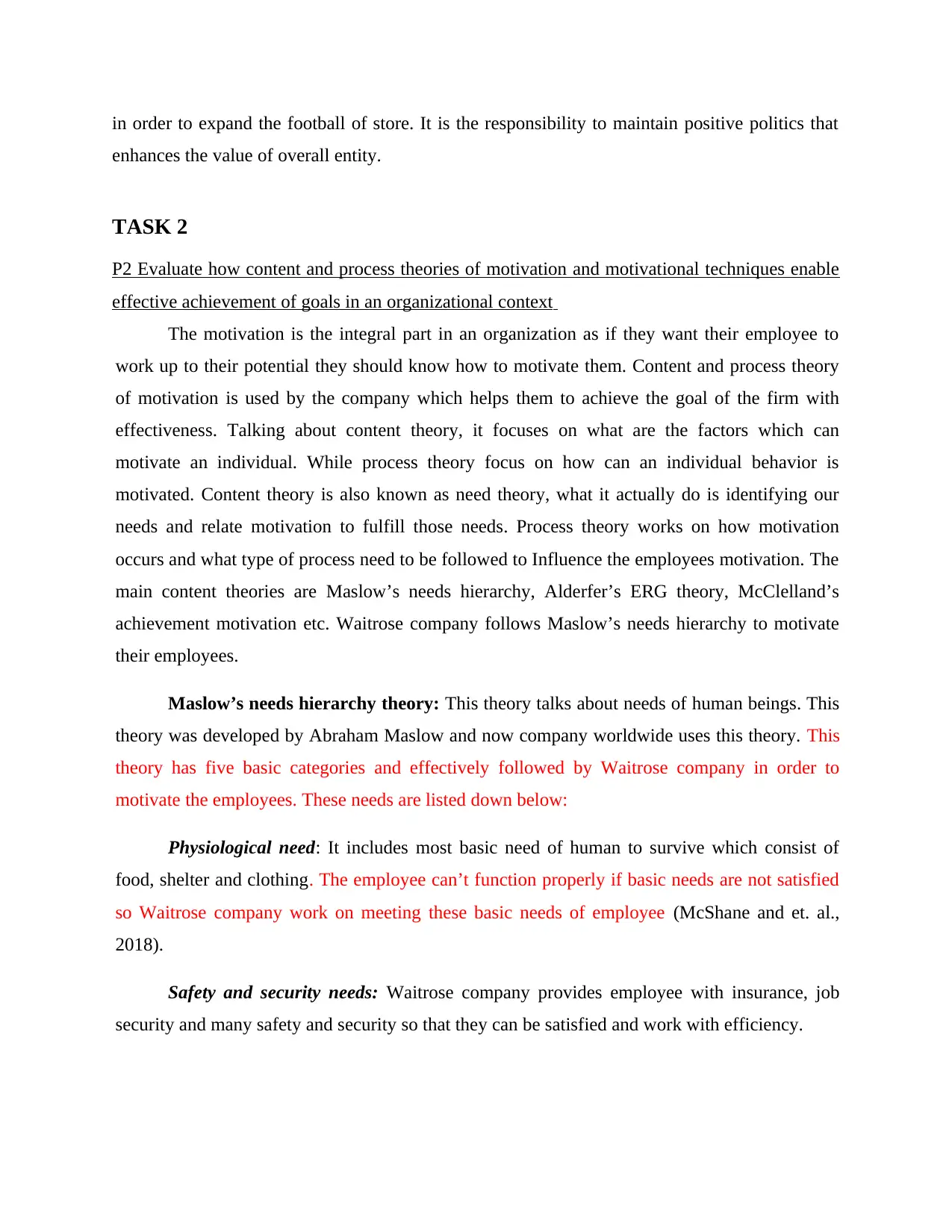
in order to expand the football of store. It is the responsibility to maintain positive politics that
enhances the value of overall entity.
TASK 2
P2 Evaluate how content and process theories of motivation and motivational techniques enable
effective achievement of goals in an organizational context
The motivation is the integral part in an organization as if they want their employee to
work up to their potential they should know how to motivate them. Content and process theory
of motivation is used by the company which helps them to achieve the goal of the firm with
effectiveness. Talking about content theory, it focuses on what are the factors which can
motivate an individual. While process theory focus on how can an individual behavior is
motivated. Content theory is also known as need theory, what it actually do is identifying our
needs and relate motivation to fulfill those needs. Process theory works on how motivation
occurs and what type of process need to be followed to Influence the employees motivation. The
main content theories are Maslow’s needs hierarchy, Alderfer’s ERG theory, McClelland’s
achievement motivation etc. Waitrose company follows Maslow’s needs hierarchy to motivate
their employees.
Maslow’s needs hierarchy theory: This theory talks about needs of human beings. This
theory was developed by Abraham Maslow and now company worldwide uses this theory. This
theory has five basic categories and effectively followed by Waitrose company in order to
motivate the employees. These needs are listed down below:
Physiological need: It includes most basic need of human to survive which consist of
food, shelter and clothing. The employee can’t function properly if basic needs are not satisfied
so Waitrose company work on meeting these basic needs of employee (McShane and et. al.,
2018).
Safety and security needs: Waitrose company provides employee with insurance, job
security and many safety and security so that they can be satisfied and work with efficiency.
enhances the value of overall entity.
TASK 2
P2 Evaluate how content and process theories of motivation and motivational techniques enable
effective achievement of goals in an organizational context
The motivation is the integral part in an organization as if they want their employee to
work up to their potential they should know how to motivate them. Content and process theory
of motivation is used by the company which helps them to achieve the goal of the firm with
effectiveness. Talking about content theory, it focuses on what are the factors which can
motivate an individual. While process theory focus on how can an individual behavior is
motivated. Content theory is also known as need theory, what it actually do is identifying our
needs and relate motivation to fulfill those needs. Process theory works on how motivation
occurs and what type of process need to be followed to Influence the employees motivation. The
main content theories are Maslow’s needs hierarchy, Alderfer’s ERG theory, McClelland’s
achievement motivation etc. Waitrose company follows Maslow’s needs hierarchy to motivate
their employees.
Maslow’s needs hierarchy theory: This theory talks about needs of human beings. This
theory was developed by Abraham Maslow and now company worldwide uses this theory. This
theory has five basic categories and effectively followed by Waitrose company in order to
motivate the employees. These needs are listed down below:
Physiological need: It includes most basic need of human to survive which consist of
food, shelter and clothing. The employee can’t function properly if basic needs are not satisfied
so Waitrose company work on meeting these basic needs of employee (McShane and et. al.,
2018).
Safety and security needs: Waitrose company provides employee with insurance, job
security and many safety and security so that they can be satisfied and work with efficiency.
Paraphrase This Document
Need a fresh take? Get an instant paraphrase of this document with our AI Paraphraser
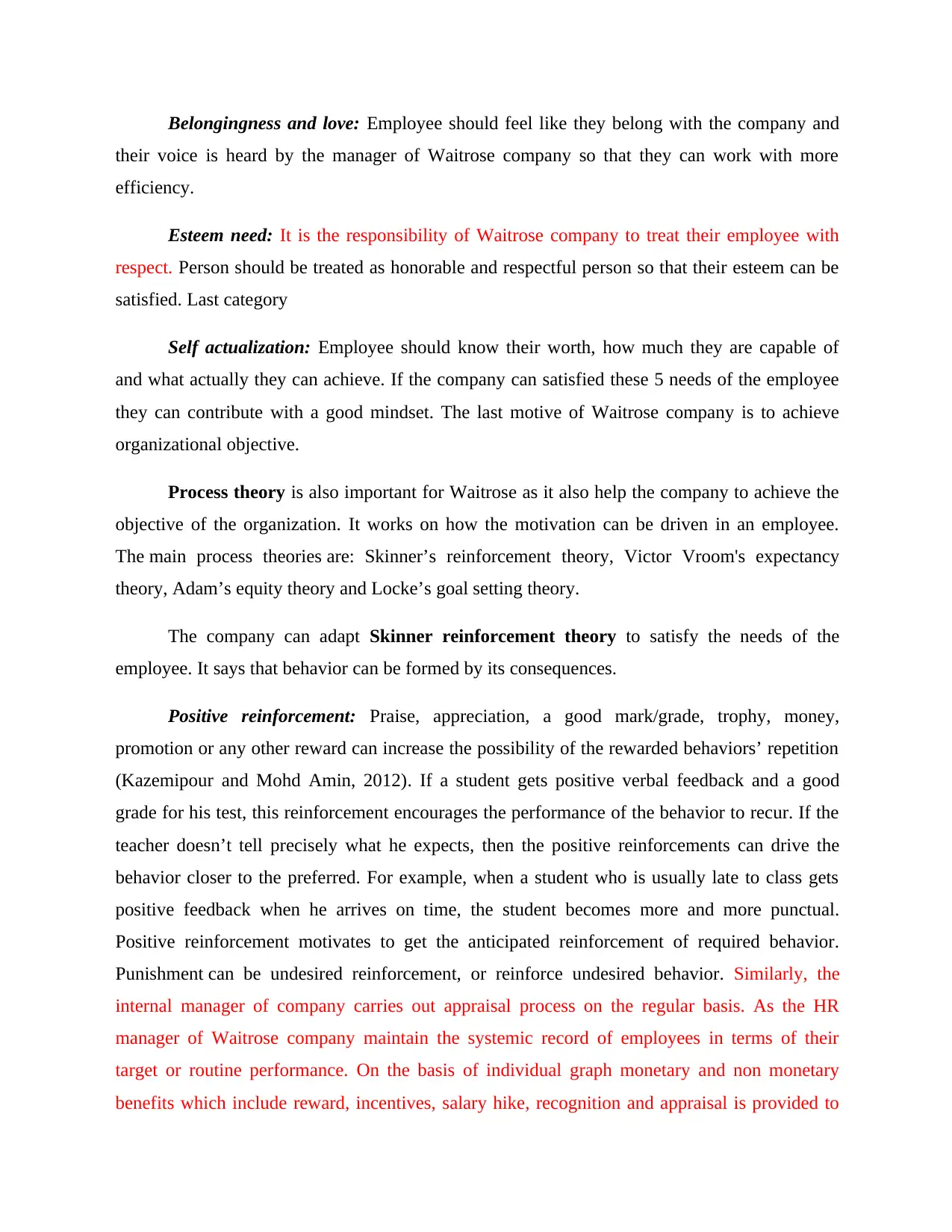
Belongingness and love: Employee should feel like they belong with the company and
their voice is heard by the manager of Waitrose company so that they can work with more
efficiency.
Esteem need: It is the responsibility of Waitrose company to treat their employee with
respect. Person should be treated as honorable and respectful person so that their esteem can be
satisfied. Last category
Self actualization: Employee should know their worth, how much they are capable of
and what actually they can achieve. If the company can satisfied these 5 needs of the employee
they can contribute with a good mindset. The last motive of Waitrose company is to achieve
organizational objective.
Process theory is also important for Waitrose as it also help the company to achieve the
objective of the organization. It works on how the motivation can be driven in an employee.
The main process theories are: Skinner’s reinforcement theory, Victor Vroom's expectancy
theory, Adam’s equity theory and Locke’s goal setting theory.
The company can adapt Skinner reinforcement theory to satisfy the needs of the
employee. It says that behavior can be formed by its consequences.
Positive reinforcement: Praise, appreciation, a good mark/grade, trophy, money,
promotion or any other reward can increase the possibility of the rewarded behaviors’ repetition
(Kazemipour and Mohd Amin, 2012). If a student gets positive verbal feedback and a good
grade for his test, this reinforcement encourages the performance of the behavior to recur. If the
teacher doesn’t tell precisely what he expects, then the positive reinforcements can drive the
behavior closer to the preferred. For example, when a student who is usually late to class gets
positive feedback when he arrives on time, the student becomes more and more punctual.
Positive reinforcement motivates to get the anticipated reinforcement of required behavior.
Punishment can be undesired reinforcement, or reinforce undesired behavior. Similarly, the
internal manager of company carries out appraisal process on the regular basis. As the HR
manager of Waitrose company maintain the systemic record of employees in terms of their
target or routine performance. On the basis of individual graph monetary and non monetary
benefits which include reward, incentives, salary hike, recognition and appraisal is provided to
their voice is heard by the manager of Waitrose company so that they can work with more
efficiency.
Esteem need: It is the responsibility of Waitrose company to treat their employee with
respect. Person should be treated as honorable and respectful person so that their esteem can be
satisfied. Last category
Self actualization: Employee should know their worth, how much they are capable of
and what actually they can achieve. If the company can satisfied these 5 needs of the employee
they can contribute with a good mindset. The last motive of Waitrose company is to achieve
organizational objective.
Process theory is also important for Waitrose as it also help the company to achieve the
objective of the organization. It works on how the motivation can be driven in an employee.
The main process theories are: Skinner’s reinforcement theory, Victor Vroom's expectancy
theory, Adam’s equity theory and Locke’s goal setting theory.
The company can adapt Skinner reinforcement theory to satisfy the needs of the
employee. It says that behavior can be formed by its consequences.
Positive reinforcement: Praise, appreciation, a good mark/grade, trophy, money,
promotion or any other reward can increase the possibility of the rewarded behaviors’ repetition
(Kazemipour and Mohd Amin, 2012). If a student gets positive verbal feedback and a good
grade for his test, this reinforcement encourages the performance of the behavior to recur. If the
teacher doesn’t tell precisely what he expects, then the positive reinforcements can drive the
behavior closer to the preferred. For example, when a student who is usually late to class gets
positive feedback when he arrives on time, the student becomes more and more punctual.
Positive reinforcement motivates to get the anticipated reinforcement of required behavior.
Punishment can be undesired reinforcement, or reinforce undesired behavior. Similarly, the
internal manager of company carries out appraisal process on the regular basis. As the HR
manager of Waitrose company maintain the systemic record of employees in terms of their
target or routine performance. On the basis of individual graph monetary and non monetary
benefits which include reward, incentives, salary hike, recognition and appraisal is provided to
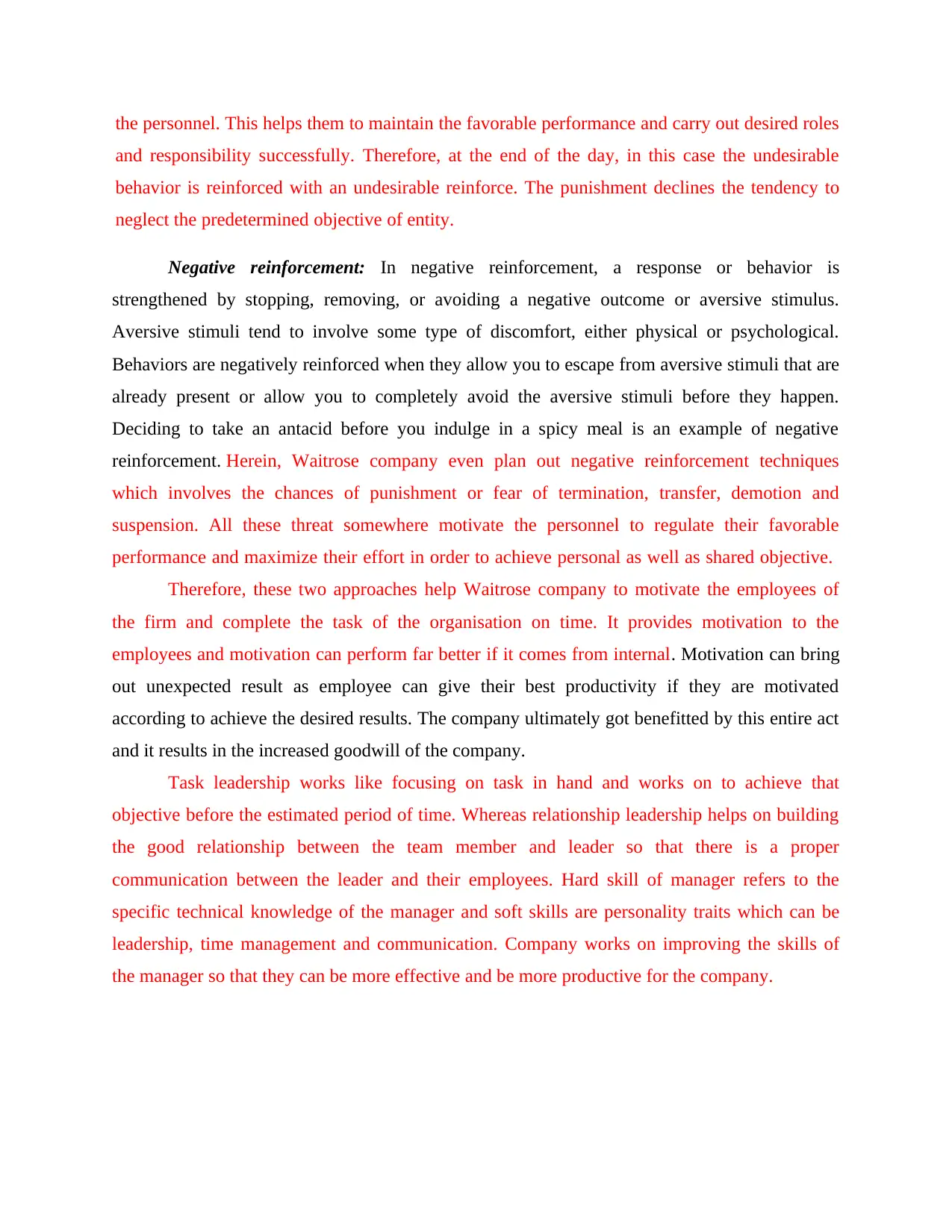
the personnel. This helps them to maintain the favorable performance and carry out desired roles
and responsibility successfully. Therefore, at the end of the day, in this case the undesirable
behavior is reinforced with an undesirable reinforce. The punishment declines the tendency to
neglect the predetermined objective of entity.
Negative reinforcement: In negative reinforcement, a response or behavior is
strengthened by stopping, removing, or avoiding a negative outcome or aversive stimulus.
Aversive stimuli tend to involve some type of discomfort, either physical or psychological.
Behaviors are negatively reinforced when they allow you to escape from aversive stimuli that are
already present or allow you to completely avoid the aversive stimuli before they happen.
Deciding to take an antacid before you indulge in a spicy meal is an example of negative
reinforcement. Herein, Waitrose company even plan out negative reinforcement techniques
which involves the chances of punishment or fear of termination, transfer, demotion and
suspension. All these threat somewhere motivate the personnel to regulate their favorable
performance and maximize their effort in order to achieve personal as well as shared objective.
Therefore, these two approaches help Waitrose company to motivate the employees of
the firm and complete the task of the organisation on time. It provides motivation to the
employees and motivation can perform far better if it comes from internal. Motivation can bring
out unexpected result as employee can give their best productivity if they are motivated
according to achieve the desired results. The company ultimately got benefitted by this entire act
and it results in the increased goodwill of the company.
Task leadership works like focusing on task in hand and works on to achieve that
objective before the estimated period of time. Whereas relationship leadership helps on building
the good relationship between the team member and leader so that there is a proper
communication between the leader and their employees. Hard skill of manager refers to the
specific technical knowledge of the manager and soft skills are personality traits which can be
leadership, time management and communication. Company works on improving the skills of
the manager so that they can be more effective and be more productive for the company.
and responsibility successfully. Therefore, at the end of the day, in this case the undesirable
behavior is reinforced with an undesirable reinforce. The punishment declines the tendency to
neglect the predetermined objective of entity.
Negative reinforcement: In negative reinforcement, a response or behavior is
strengthened by stopping, removing, or avoiding a negative outcome or aversive stimulus.
Aversive stimuli tend to involve some type of discomfort, either physical or psychological.
Behaviors are negatively reinforced when they allow you to escape from aversive stimuli that are
already present or allow you to completely avoid the aversive stimuli before they happen.
Deciding to take an antacid before you indulge in a spicy meal is an example of negative
reinforcement. Herein, Waitrose company even plan out negative reinforcement techniques
which involves the chances of punishment or fear of termination, transfer, demotion and
suspension. All these threat somewhere motivate the personnel to regulate their favorable
performance and maximize their effort in order to achieve personal as well as shared objective.
Therefore, these two approaches help Waitrose company to motivate the employees of
the firm and complete the task of the organisation on time. It provides motivation to the
employees and motivation can perform far better if it comes from internal. Motivation can bring
out unexpected result as employee can give their best productivity if they are motivated
according to achieve the desired results. The company ultimately got benefitted by this entire act
and it results in the increased goodwill of the company.
Task leadership works like focusing on task in hand and works on to achieve that
objective before the estimated period of time. Whereas relationship leadership helps on building
the good relationship between the team member and leader so that there is a proper
communication between the leader and their employees. Hard skill of manager refers to the
specific technical knowledge of the manager and soft skills are personality traits which can be
leadership, time management and communication. Company works on improving the skills of
the manager so that they can be more effective and be more productive for the company.
⊘ This is a preview!⊘
Do you want full access?
Subscribe today to unlock all pages.

Trusted by 1+ million students worldwide
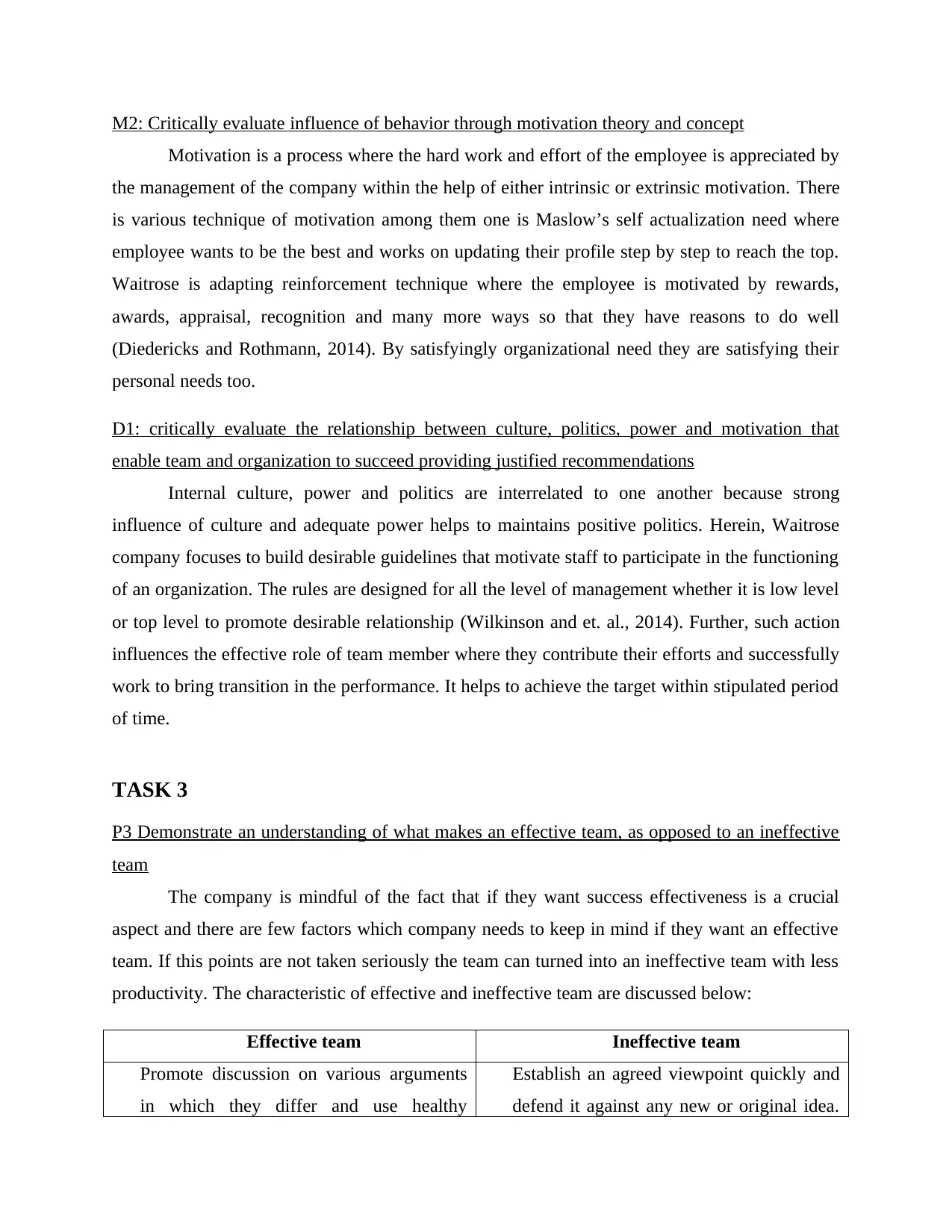
M2: Critically evaluate influence of behavior through motivation theory and concept
Motivation is a process where the hard work and effort of the employee is appreciated by
the management of the company within the help of either intrinsic or extrinsic motivation. There
is various technique of motivation among them one is Maslow’s self actualization need where
employee wants to be the best and works on updating their profile step by step to reach the top.
Waitrose is adapting reinforcement technique where the employee is motivated by rewards,
awards, appraisal, recognition and many more ways so that they have reasons to do well
(Diedericks and Rothmann, 2014). By satisfyingly organizational need they are satisfying their
personal needs too.
D1: critically evaluate the relationship between culture, politics, power and motivation that
enable team and organization to succeed providing justified recommendations
Internal culture, power and politics are interrelated to one another because strong
influence of culture and adequate power helps to maintains positive politics. Herein, Waitrose
company focuses to build desirable guidelines that motivate staff to participate in the functioning
of an organization. The rules are designed for all the level of management whether it is low level
or top level to promote desirable relationship (Wilkinson and et. al., 2014). Further, such action
influences the effective role of team member where they contribute their efforts and successfully
work to bring transition in the performance. It helps to achieve the target within stipulated period
of time.
TASK 3
P3 Demonstrate an understanding of what makes an effective team, as opposed to an ineffective
team
The company is mindful of the fact that if they want success effectiveness is a crucial
aspect and there are few factors which company needs to keep in mind if they want an effective
team. If this points are not taken seriously the team can turned into an ineffective team with less
productivity. The characteristic of effective and ineffective team are discussed below:
Effective team Ineffective team
Promote discussion on various arguments
in which they differ and use healthy
Establish an agreed viewpoint quickly and
defend it against any new or original idea.
Motivation is a process where the hard work and effort of the employee is appreciated by
the management of the company within the help of either intrinsic or extrinsic motivation. There
is various technique of motivation among them one is Maslow’s self actualization need where
employee wants to be the best and works on updating their profile step by step to reach the top.
Waitrose is adapting reinforcement technique where the employee is motivated by rewards,
awards, appraisal, recognition and many more ways so that they have reasons to do well
(Diedericks and Rothmann, 2014). By satisfyingly organizational need they are satisfying their
personal needs too.
D1: critically evaluate the relationship between culture, politics, power and motivation that
enable team and organization to succeed providing justified recommendations
Internal culture, power and politics are interrelated to one another because strong
influence of culture and adequate power helps to maintains positive politics. Herein, Waitrose
company focuses to build desirable guidelines that motivate staff to participate in the functioning
of an organization. The rules are designed for all the level of management whether it is low level
or top level to promote desirable relationship (Wilkinson and et. al., 2014). Further, such action
influences the effective role of team member where they contribute their efforts and successfully
work to bring transition in the performance. It helps to achieve the target within stipulated period
of time.
TASK 3
P3 Demonstrate an understanding of what makes an effective team, as opposed to an ineffective
team
The company is mindful of the fact that if they want success effectiveness is a crucial
aspect and there are few factors which company needs to keep in mind if they want an effective
team. If this points are not taken seriously the team can turned into an ineffective team with less
productivity. The characteristic of effective and ineffective team are discussed below:
Effective team Ineffective team
Promote discussion on various arguments
in which they differ and use healthy
Establish an agreed viewpoint quickly and
defend it against any new or original idea.
Paraphrase This Document
Need a fresh take? Get an instant paraphrase of this document with our AI Paraphraser
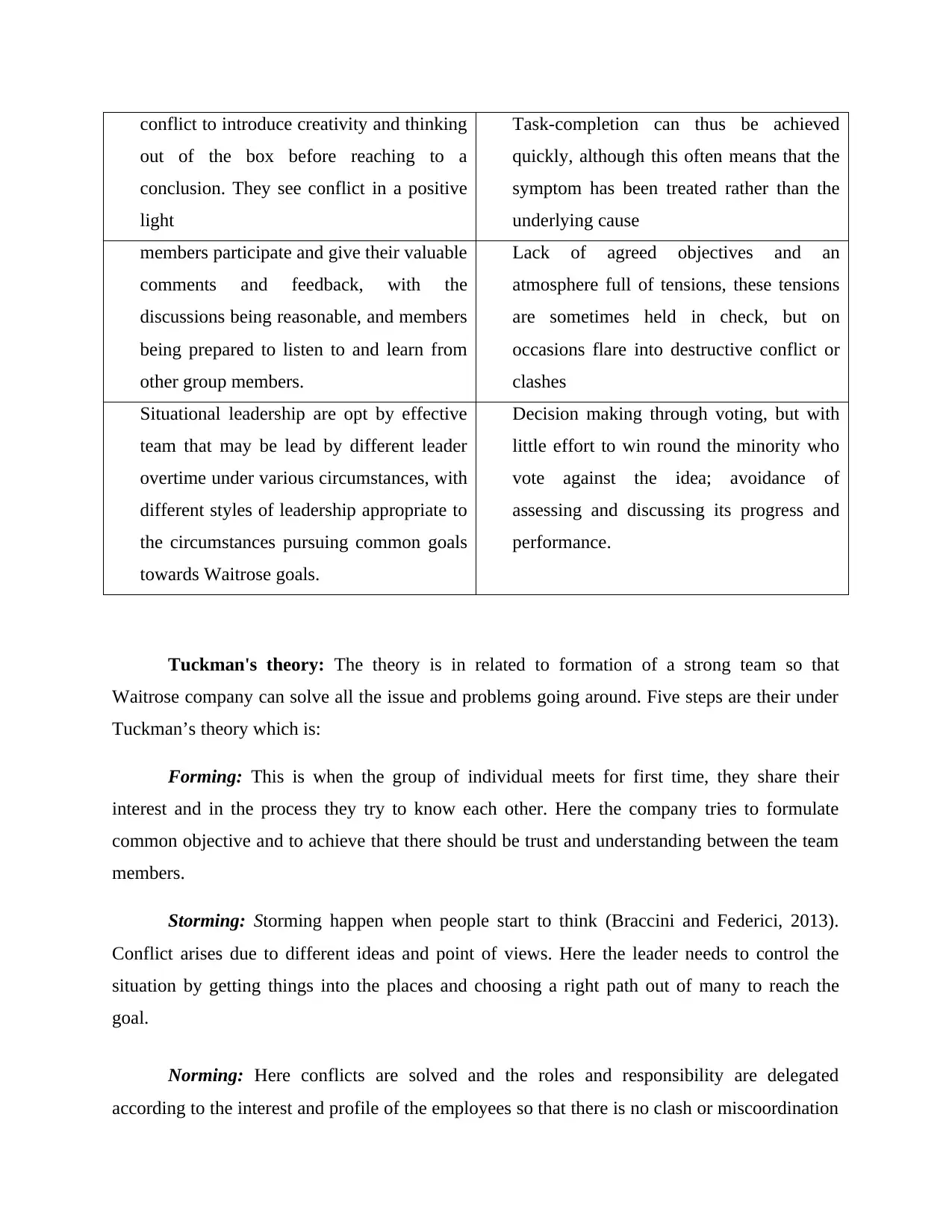
conflict to introduce creativity and thinking
out of the box before reaching to a
conclusion. They see conflict in a positive
light
Task-completion can thus be achieved
quickly, although this often means that the
symptom has been treated rather than the
underlying cause
members participate and give their valuable
comments and feedback, with the
discussions being reasonable, and members
being prepared to listen to and learn from
other group members.
Lack of agreed objectives and an
atmosphere full of tensions, these tensions
are sometimes held in check, but on
occasions flare into destructive conflict or
clashes
Situational leadership are opt by effective
team that may be lead by different leader
overtime under various circumstances, with
different styles of leadership appropriate to
the circumstances pursuing common goals
towards Waitrose goals.
Decision making through voting, but with
little effort to win round the minority who
vote against the idea; avoidance of
assessing and discussing its progress and
performance.
Tuckman's theory: The theory is in related to formation of a strong team so that
Waitrose company can solve all the issue and problems going around. Five steps are their under
Tuckman’s theory which is:
Forming: This is when the group of individual meets for first time, they share their
interest and in the process they try to know each other. Here the company tries to formulate
common objective and to achieve that there should be trust and understanding between the team
members.
Storming: Storming happen when people start to think (Braccini and Federici, 2013).
Conflict arises due to different ideas and point of views. Here the leader needs to control the
situation by getting things into the places and choosing a right path out of many to reach the
goal.
Norming: Here conflicts are solved and the roles and responsibility are delegated
according to the interest and profile of the employees so that there is no clash or miscoordination
out of the box before reaching to a
conclusion. They see conflict in a positive
light
Task-completion can thus be achieved
quickly, although this often means that the
symptom has been treated rather than the
underlying cause
members participate and give their valuable
comments and feedback, with the
discussions being reasonable, and members
being prepared to listen to and learn from
other group members.
Lack of agreed objectives and an
atmosphere full of tensions, these tensions
are sometimes held in check, but on
occasions flare into destructive conflict or
clashes
Situational leadership are opt by effective
team that may be lead by different leader
overtime under various circumstances, with
different styles of leadership appropriate to
the circumstances pursuing common goals
towards Waitrose goals.
Decision making through voting, but with
little effort to win round the minority who
vote against the idea; avoidance of
assessing and discussing its progress and
performance.
Tuckman's theory: The theory is in related to formation of a strong team so that
Waitrose company can solve all the issue and problems going around. Five steps are their under
Tuckman’s theory which is:
Forming: This is when the group of individual meets for first time, they share their
interest and in the process they try to know each other. Here the company tries to formulate
common objective and to achieve that there should be trust and understanding between the team
members.
Storming: Storming happen when people start to think (Braccini and Federici, 2013).
Conflict arises due to different ideas and point of views. Here the leader needs to control the
situation by getting things into the places and choosing a right path out of many to reach the
goal.
Norming: Here conflicts are solved and the roles and responsibility are delegated
according to the interest and profile of the employees so that there is no clash or miscoordination
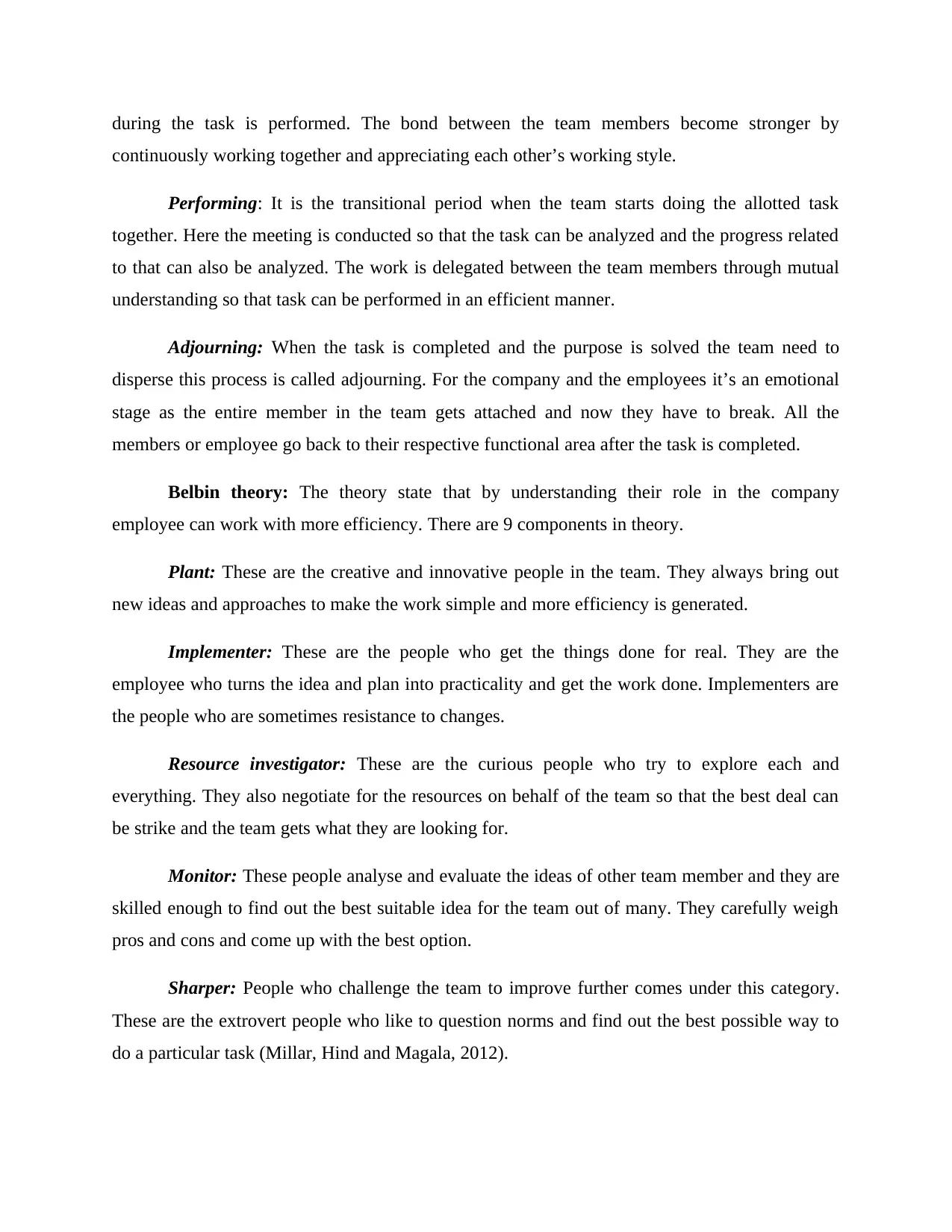
during the task is performed. The bond between the team members become stronger by
continuously working together and appreciating each other’s working style.
Performing: It is the transitional period when the team starts doing the allotted task
together. Here the meeting is conducted so that the task can be analyzed and the progress related
to that can also be analyzed. The work is delegated between the team members through mutual
understanding so that task can be performed in an efficient manner.
Adjourning: When the task is completed and the purpose is solved the team need to
disperse this process is called adjourning. For the company and the employees it’s an emotional
stage as the entire member in the team gets attached and now they have to break. All the
members or employee go back to their respective functional area after the task is completed.
Belbin theory: The theory state that by understanding their role in the company
employee can work with more efficiency. There are 9 components in theory.
Plant: These are the creative and innovative people in the team. They always bring out
new ideas and approaches to make the work simple and more efficiency is generated.
Implementer: These are the people who get the things done for real. They are the
employee who turns the idea and plan into practicality and get the work done. Implementers are
the people who are sometimes resistance to changes.
Resource investigator: These are the curious people who try to explore each and
everything. They also negotiate for the resources on behalf of the team so that the best deal can
be strike and the team gets what they are looking for.
Monitor: These people analyse and evaluate the ideas of other team member and they are
skilled enough to find out the best suitable idea for the team out of many. They carefully weigh
pros and cons and come up with the best option.
Sharper: People who challenge the team to improve further comes under this category.
These are the extrovert people who like to question norms and find out the best possible way to
do a particular task (Millar, Hind and Magala, 2012).
continuously working together and appreciating each other’s working style.
Performing: It is the transitional period when the team starts doing the allotted task
together. Here the meeting is conducted so that the task can be analyzed and the progress related
to that can also be analyzed. The work is delegated between the team members through mutual
understanding so that task can be performed in an efficient manner.
Adjourning: When the task is completed and the purpose is solved the team need to
disperse this process is called adjourning. For the company and the employees it’s an emotional
stage as the entire member in the team gets attached and now they have to break. All the
members or employee go back to their respective functional area after the task is completed.
Belbin theory: The theory state that by understanding their role in the company
employee can work with more efficiency. There are 9 components in theory.
Plant: These are the creative and innovative people in the team. They always bring out
new ideas and approaches to make the work simple and more efficiency is generated.
Implementer: These are the people who get the things done for real. They are the
employee who turns the idea and plan into practicality and get the work done. Implementers are
the people who are sometimes resistance to changes.
Resource investigator: These are the curious people who try to explore each and
everything. They also negotiate for the resources on behalf of the team so that the best deal can
be strike and the team gets what they are looking for.
Monitor: These people analyse and evaluate the ideas of other team member and they are
skilled enough to find out the best suitable idea for the team out of many. They carefully weigh
pros and cons and come up with the best option.
Sharper: People who challenge the team to improve further comes under this category.
These are the extrovert people who like to question norms and find out the best possible way to
do a particular task (Millar, Hind and Magala, 2012).
⊘ This is a preview!⊘
Do you want full access?
Subscribe today to unlock all pages.

Trusted by 1+ million students worldwide
1 out of 17
Related Documents
Your All-in-One AI-Powered Toolkit for Academic Success.
+13062052269
info@desklib.com
Available 24*7 on WhatsApp / Email
![[object Object]](/_next/static/media/star-bottom.7253800d.svg)
Unlock your academic potential
Copyright © 2020–2025 A2Z Services. All Rights Reserved. Developed and managed by ZUCOL.




